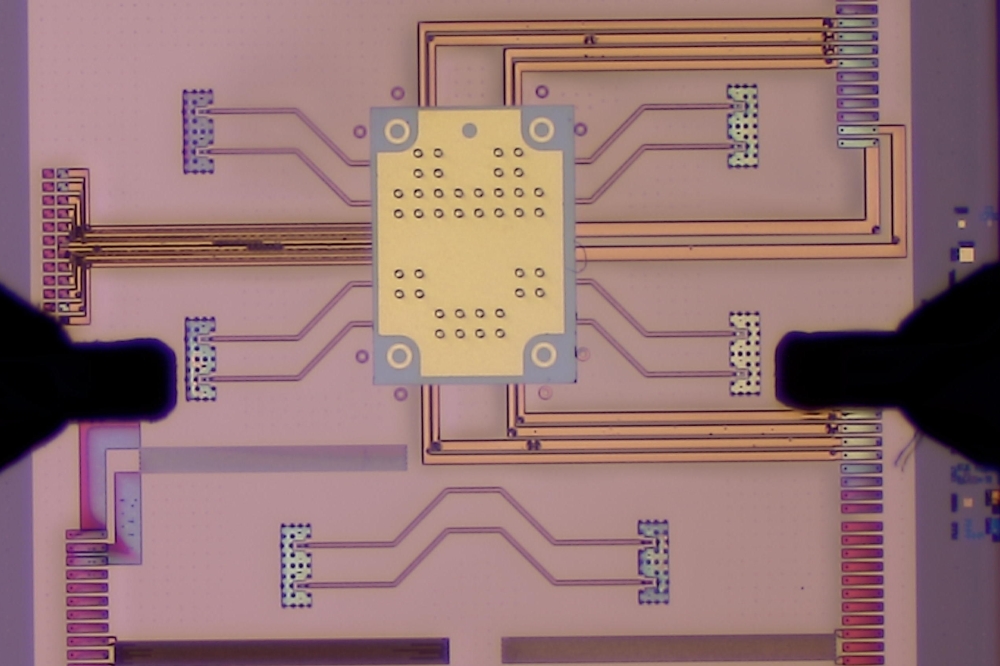"First light" for upgraded Australia Telescope
New world-leading technology has made CSIRO s Australia Telescope the first radio telescope in the Southern Hemisphere able to make detailed pictures of evolving galaxies and the birthplaces of young stars.
Installed and tested last week, it makes the radio telescope the first millimetre-wave interferometer in the Southern Hemisphere and the first anywhere with this technology.
At the heart of the system is a new chip made of the exotic material indium phosphide, cooled to 20 K (-253degC).
The upgrading of the Australia Telescope to work at millimetre wavelengths is funded by the Federal Government under its Major National Research Facilities (MNRF) Program, and by CSIRO.
Astronomers in the Southern Hemisphere have a ringside seat looking straight into the centre of our own Galaxy and at the two nearest galaxies, the Magellanic Clouds.
"As the Australia Telescope is the only telescope of its kind in the Southern Hemisphere it is already in heavy demand from overseas organisations, with more than eighty applying each year to use it," according to Dr Dave McConnell, Officer-in-Charge of the Australia Telescope s Narrabri Observatory.
"We expect that even more of the world will now beat a path to our door."
The Australia Telescope is a set of six 22-m diameter dishes ( antennas ) that collect radio waves from objects in space.
Last Thursday [30 November] the first two dishes fitted with the new receiving systems were trained on a clutch of young stars bursting into life in the constellation Orion. At 11.45 pm the telescope captured its first cosmic millimetre-wave photons, achieving "first light".
"Those photons were born together 1500 years ago in this stellar nursery, and travelled separately through space ever since," says Dr Warwick Wilson, Head of the Australia Telescope Electronics Group. "To get detailed information about their source we had to bring them together again with a time-lag accurate to better than a tenth of a microsecond."
Astronomers have been using the basic technique of interferometry for more than 50 years but the shorter the wavelengths involved, the harder it is to do. The telescope s new receiving systems handle radio waves only 3 mm long.
"High-resolution imaging with millimetre waves is extremely challenging," says Mr John Brooks, Australia Telescope National Facility (ATNF) Engineering Manager. "In achieving this we ve conquered an engineering Everest."
Millimetre waves have two big advantages, says CSIRO s Professor Ray Norris, Project Scientist for the upgrade.
"With radio waves ten times smaller than before we ll see ten times more detail in the objects we study -- our Galaxy, stars being born, other galaxies, and gas clouds."
"And millimetre-waves are especially good for detecting molecules in space. They ll let us track how galaxies evolve over time, for instance, and how dense clouds of gas collapse to form stars," he explains.
"With forming stars we d hope to see signs of forming planets."
Receiving systems to handle both 3-mm and 12-mm radio waves have been installed on two of the Australia Telescope s six dishes. Between now and the end of 2002 the same systems will be installed on another three dishes. Routine millimetre-wave observing will start in mid 2003.
Europe, the USA, Canada and Japan are collaborating on a $US 750 million project to build a millimetre-wave interferometer in Chile. Known as the Atacama Large Millimeter Array (ALMA), it will be completed around 2008.
"The Australia Telescope will be the world s most powerful array at 3-mm wavelengths until ALMA starts up," says Professor Norris.
The chip at the heart of the new receiving system is a monolithic microwave integrated circuit (MMIC). It is one of several components being jointly developed by the ATNF and its sister CSIRO Division, Telecommunications and Industrial Physics under a special program established by former CSIRO Chief Executive Malcolm McIntosh.
"Astronomy is a technology driver," explains Mr Malcolm Sinclair, Head of the Australia Telescope Receiver Group.
"This technology is a showpiece for Australia, benchmarked against the most advanced systems in other countries."
The same technology that Australian scientists will use to explore the universe will also help keep Australia at the forefront of the global information technology and telecommunications industries.
"Millimetre waves are the next area of commercial interest as users go to higher and higher frequencies," says Dr Alan Young of CSIRO Telecommunications and Industrial Physics.
"Carriers in Australia alone have recently spent around $80M buying spectrum at the edge of the millimetre region."
"CSIRO is working with both carriers and leading-edge suppliers on next- generation technologies. Some of the background expertise came from radio astronomy," he adds.
CONTACT: Professor Ray Norris, CSIRO Australia Telescope National Facility Tel: +61 02 9372 4416 e-mail: rnorris@atnf.csiro.au Mr John Brooks, CSIRO Australia Telescope National Facility Tel: +61 02 9372 4227 e-mail: jbrooks@atnf.csiro.au Dr Dave McConnell, CSIRO Australia Telescope National Facility Tel: +61 02 6790 4050 e-mail: dmcconne@atnf.csiro.au Dr Warwick Wilson, CSIRO Australia Telescope National Facility Tel: +61 02 9372 4324 e-mail: wwilson@atnf.csiro.au Mr Malcolm Sinclair, CSIRO Australia Telescope National Facility Tel: +61 02 9372 4317 e-mail: msinclai@atnf.csiro.au Dr Alan Young, CSIRO Telecommunications and Industrial Physics Tel: +61 02 9372 4469 e-mail: Alan.Young@tip.csiro.au
Professor Ray Norris, CSIRO Australia Telescope NationalFacility
Tel: +61 02 9372 4416
e-mail: rnorris@atnf.csiro.au
Mr John Brooks, CSIRO Australia Telescope National Facility
Tel: +61 02 9372 4227
e-mail: jbrooks@atnf.csiro.au
Dr Dave McConnell, CSIRO Australia Telescope National Facility
Tel: +61 02 6790 4050
e-mail: dmcconne@atnf.csiro.au
Dr Warwick Wilson, CSIRO Australia Telescope National Facility
Tel: +61 02 9372 4324
e-mail: wwilson@atnf.csiro.au
Mr Malcolm Sinclair, CSIRO Australia Telescope National Facility
Tel: +61 02 9372 4317
e-mail: msinclai@atnf.csiro.au
Dr Alan Young, CSIRO Telecommunications and Industrial Physics
Tel: +61 02 9372 4469
e-mail: Alan.Young@tip.csiro.au
E-mail: Alan.Young@tip.csiro.au































